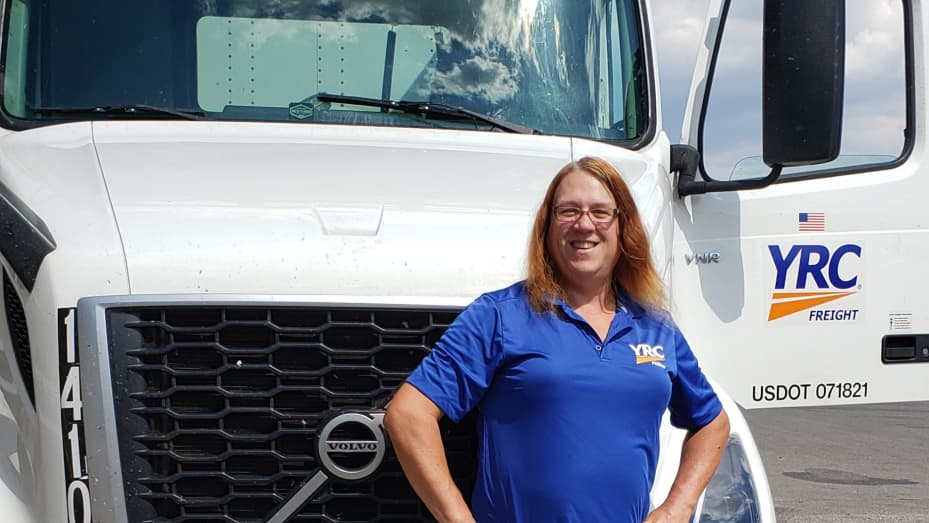After 13 years in teaching and education administration, Vanita Johnson switched to a position she always wanted — behind the wheel of a big rig.
Johnson took a three-week course in trucking, got her commercial driver’s license, and became an independent owner-operator. She eventually joined a larger company and has been hauling shipments for over two years.
She’s one of many in the trucking industry-leading efforts to bring more women into the fold. Associations like Women In Trucking work to increase the rate of women drivers, technicians and executives, particularly younger women or those switching careers, like Johnson.
“Trucking comes with its ups and downs, but you can overcome each challenge because we have women pioneers that were out there before us that have paved the way,” Johnson said. “You have that support route there to help you navigate through this male-populated industry, and it offers freedom and travel.”
Johnson said during her time in trucking she’s found her male counterparts to go above and beyond to help her navigate the industry. The wages have also been a plus compared with her teaching salary, she said.
Efforts to introduce more women to trucking became even more pressing when the Covid pandemic took hold in the U.S., sending the service and education industries into upheaval. Comparatively, trucking never slowed down. Many teachers and service workers made the switch to trucking, along with nurses and other women from the medical field who faced burnout.
Now, with the industry facing a daunting driver shortage, initiatives to bring in women drivers from other industries have escalated. Unions including the International Brotherhood of Teamsters have worked to end violence and harassment of women on the job and remove barriers to women entering the industry, including safety risks, wage inequities, and lack of training and support.
The share of women truckers has increased significantly in recent years: Women now make up almost 8% of truck drivers and sales delivery drivers, according to the U.S. Bureau of Labor Statistics. That number is even higher — 14% — for Class A licensed road drivers (which includes any driver who can operate vehicles weighing over 26,000 pounds), almost double what it was just five years ago, according to the 2022 Women In Trucking Index.
Women also account for a third of C-Suite executives in transportation, compared with nearly 24% in executive positions four years earlier, according to the index.
Ellen Voie, CEO of WIT, said women often make for quality candidates as truckers because they’re less likely than men to take risks on the road, and they possess strong multi-tasking, communication, and organizational skills. According to the American Transportation Research Institute, male commercial drivers are 20% more likely to be involved in a crash in areas such as traversing intersections.
“More and more women are going into safety roles, like director safety or safety manager, and that’s a great place for women because women are more risk averse, whether it’s in the boardroom or whether it’s as a driver,” Voie said.
Navigating shortages
Though many women joined the industry during the pandemic, Covid-19 lockdowns stalled training and testing for truck drivers. Supply chain disruptions during the pandemic, along with surging demand, exacerbated a years-long trucker shortage.
The American Trucking Association reported a shortage of 80,000 drivers in 2021 and has cautioned the shortfall could reach 160,000 by 2030.
To address demand, the industry would have to recruit a million new drivers over the next decade, according to the ATA — although as of 2021, there were just under 2.1 million people employed as heavy and tractor-trailer truck drivers, according to the Bureau of Labor Statistics.
A BLS report found annual turnover rates at large truckload carriers averaged 94% between 1995 and 2017.
Demand for product and driver numbers appear to be improving this year, said Mike Kucharski, vice president of Illinois-based J.K.C. Trucking. Volume volatility remains a major problem — leaving the industry in flux with regard to hiring.
“The American people are changing their diet, they can’t afford things as they used to, so with those things happening, the typical budget and volumes are coming down,” said Kucharski. “We’re kind of all fighting for the same product, and we’re not as busy as we used to be due to inflation.”
Many truckers are paid only for driving time and are not compensated for overtime or time spent waiting for loading and unloading goods, adding to uncertainty for workers. Many also pay their own fuel costs and lack health care benefits.

Angelique Temple, who has been in the trucking industry for 23 years, spent two decades pulling hazmat as a company driver, during which time she raised six kids. She switched gears in 2021 to become the owner-operator of her own company Tornado Transport, although she almost lost her business, as she was paying $5,000 a week just for fuel.
Temple said she now drives routes of under 200 miles and works with local brokers to help ease “rollercoaster” price fluctuations. She runs medical supplies, dry food, and other essential products while setting her own prices.
It’s not so much a driver shortage, she said, as it is a shortage of qualified professionals.
“You don’t have a lot of people out there that have the dedication and loyalty that it takes to do what needs to be done,” Temple said. “They don’t want to sacrifice. They just want to run and come back and make their money.”
Women rev up for the industry
Women have been joining the trucking industry at higher rates for more than behind-the-wheel positions. According to the 2022 WIT Index, women in both dispatcher and safety roles topped 40%, while women in human resources and talent management averaged nearly 75%.
Women in technician roles, however, represent just 3.7%, according to WIT. The ATA found the industry will need about 200,000 technicians over the next decade to keep up with maintenance demands. The organization’s Women In Motion initiative hopes to accelerate progress to bring women into those roles.
Trucks were designed for men. Uniforms were made for men. We didn’t even have showers at the truck stops for women because they were locker room showers, so really it wasn’t a level playing field.Ellen VoieCEO OF WOMEN IN TRUCKING
According to a February survey by insurance agency JW Surety Bonds, 83% of female truckers believed more young people should get into trucking. The survey of 386 truck drivers — 60% of whom were female — found female truckers was 18% less likely than male truckers to feel lonely on the job and 28% less likely to regret becoming a truck driver.
“There are TikTok videos [where] a lot of women were excited to work independently, their schedules tended to be more flexible, and they’re seeing great pay,” said Maddie Weirman, reactive data lead at marketing agency Fractl, who led the research. “Women are starting to see that there are opportunities for them.”
About 56% of female truckers made between $50,000 and $100,000 a year, while 41% made under $50,000, according to JW Surety Bonds.
Driver software company Tenstreet found earlier this year that women were more likely than men to say they were paid fairly for their work at 58.5%, compared to 55.3% for men.
Women were also more likely to be newer to professional driving and have driven for fewer carriers, yet women were more likely to report a good relationship with their dispatcher, according to the Tenstreet data.
Brad Fulton, director of research and analytics at Tenstreet, said many women have been entering the industry “on the ground floor” with hopes of shaping it to be more equal and accommodating.
“As women are getting more experience, they’re starting to realize some of the stresses,” Fulton said, adding that he expects the industry to start focusing more on work-life balance so workers are not “driving themselves into the ground.”
There are safety concerns, too. A smaller proportion of women truckers, 68%, reported feeling safe when working on the whole, according to JW Surety Bonds, compared with 78% of male truckers. A majority of women surveyed reported carrying pepper spray and a knife to defend themselves in the event of harassment or assault.
Empowering women truckers
Sixteen years ago, when Voie launched WIT, the industry was just 3% women. Now, the women-focused organization has over 8,000 members in 10 countries.
“Trucks were designed for men. Uniforms were made for men. We didn’t even have showers at the truck stops for women because they were locker room showers, so really it wasn’t a level playing field,” Voie said.
WIT runs a Driver Ambassador Program for hands-on learning, as well as recognition programs like a member of the month. WIT also provides mentorship for those entering the industry, as well as self-defense training and anti-harassment initiatives.
Voie said social media has been instrumental in bringing attention to the industry. Clarissa Rankin, a professional truck driver for five years, runs a trucking account on TikTok that has pulled in nearly 40 million likes.
“One of our top hits on TikTok was just a driver doing a pre-trip inspection, and we know it’s not truck drivers who are watching because they do a pre-trip inspection every day,” Voie said. “It’s people who are curious about the industry and also curious about women being able to do this job.”

Regan Morton, a transgender woman in Indiana who helps lead WIT’s LGBTQ Task Force, said the industry has made her feel welcome. But she believes companies should better target potential drivers from the LGBTQ community.
“The trucking industry, as far as the LGBTQ community, allows you to be able to be yourself throughout the day and not have to constantly deal with other people,” said Morton, who is a Teamsters member.
Morton, whose father was a truck driver, said healthcare coverage is often a hurdle, especially for LGBTQ drivers. She said increasingly strict health regulations have made it difficult for drivers with conditions like diabetes to even enter the industry, adding that the long days make it hard to get home for doctor appointments. Some common insurance plans for drivers do not cover all health care needs throughout the gender transition process, she said.
Despite these challenges, Voie said she sees more women-owned trucking businesses, as well as more women taking over their families’ trucking companies. WIT partnered with Expediter Services to help establish 150 women-owned businesses in transportation, including financing women drivers’ first trucks.
Cari Baylor, president of her family’s eight-decade business, Baylor Trucking, called her family’s story a “Steven Spielberg, Tom Hanks kind of American dream story,” growing from one truck to over 200.
Baylor Trucking once “saved Thanksgiving in Canada,” she said, after delivering Ocean Spray cranberry sauce shipments. The company also works with expedited shippers to deliver IVF kits, chemotherapy treatments, and even Taylor Swift and NCAA merch.
She said the industry has made strides in being more inclusive through improvements like automatic transmissions for all body types, more flexible work weeks, and advanced technology equipped with everything from video capabilities to radar.
The industry still has a ways to go with regard to installing better amenities at rest areas and adding safer truck parking, Baylor said, though she noted the benefits of introducing more women into trucking are wide-reading.
“The trucking industry learned a lesson during the pandemic that we have to be more adaptive to healthier lifestyles for professional drivers regardless of sex,” Baylor said. “I want young women and those graduating from college to realize that they have so many opportunities beyond the professional driving role in the transportation industry.”

